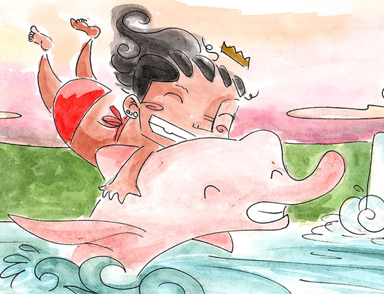Teacher's support sheet

The Green Valley Princess
Sofia is a beautiful princess that lives in Green Valley, a distant kingdom full of trees, rivers and mountains. One day, at the top of a very tall tree, Sofia realized that something was not right. Her kingdom was threatened and only with the help of her friends could the situation be resolved. Embark with little Sofia on this adventure in love with nature!

Teacher’s tips
Level of education: Elementary School
Age: 06 to 08 years old
How to take care of what you don't know? This questioning is essential when promoting environmental education work with children. Young people most engaged with environmental preservation are those who had a childhood connected with nature. This promotes a future with young people who are more aware of their role in the world, with the desire to be close to nature and preserve it. For this to actually happen, activities need to be proposed from the early grades and bring playfulness an excellent strategy for environmental education to happen. It is important that this work extends beyond the walls of the school, where students must take this information to their families and community.
Learner outcomes
Know the environmental impacts caused by individual and collective human action; Understand the importance of forest conservation; Understand what is and the importance of sustainability; Understand that simple actions can contribute to improving environmental quality; Analyze facts and situations about garbage, from an environmental point of view, recognizing the need to participate in this process; Develop text reading and interpretation; Understand the use of the alphabet in the construction of words; Expand vocabulary; Understand the importance of healthy eating; Understanding that poor nutrition can pose risks to their development;
Teachers’ goals
Explain the concept and importance of sustainable development; Stimulate the change of habits and the formation of new habits that favor the environment and nature; Promote reflection on each individual's responsibility for the environment; Work on reading and text interpretation skills; Provide, in a playful and creative way, the progress in the reading and writing process of children; Expand the class's repertoire of letters and words; Offer the game as a didactic resource to fix the content worked in the classroom; Expand students' knowledge;
Suggestions of approaches for the teacher
Step 1: Ask students to get together as a group to propose strategies for improving the school environment.
Example: selective collection, cleaning, fixing leaking faucets, saving water.
Step 2: Ask students to create a booklet or poster with guidance on new habits for the school environment.
Step 3: Watch the Wall-e movie.
Step 4: Debate the film, where students should write the moral of the story. Finish with a drawing and present your reflection to the class.
Step 5: Revitalize some part of the school garden.
More about it
According to UNESCO, the four objectives of environmental education for children are:
Raise awareness and sensitize them in relation to environmental problems.
Foster their interest in caring for and improving the environment.
Develop in childhood the ability to learn about the environment that surrounds us.
Expand your ecological knowledge, in subjects such as energy, landscape, air, water, natural resources and wildlife.
The education of the new generations is everyone's responsibility, not just the parents. Sustainability and the Environment must be taught from an early age, and the School must adopt these values in its proposal. Today's children will be tomorrow's rulers and world leaders and will have to deal with major challenges — such as global warming or water stress — and make crucial decisions for humanity.
